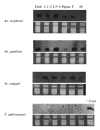Direct sequencing and expression analysis of a large number of miRNAs in Aedes aegypti and a multi-species survey of novel mosquito miRNAs
- PMID: 19961592
- PMCID: PMC2797818
- DOI: 10.1186/1471-2164-10-581
Direct sequencing and expression analysis of a large number of miRNAs in Aedes aegypti and a multi-species survey of novel mosquito miRNAs
Abstract
Background: MicroRNAs (miRNAs) are a novel class of gene regulators whose biogenesis involves hairpin structures called precursor miRNAs, or pre-miRNAs. A pre-miRNA is processed to make a miRNA:miRNA* duplex, which is then separated to generate a mature miRNA and a miRNA*. The mature miRNAs play key regulatory roles during embryonic development as well as other cellular processes. They are also implicated in control of viral infection as well as innate immunity. Direct experimental evidence for mosquito miRNAs has been recently reported in anopheline mosquitoes based on small-scale cloning efforts.
Results: We obtained approximately 130, 000 small RNA sequences from the yellow fever mosquito, Aedes aegypti, by 454 sequencing of samples that were isolated from mixed-age embryos and midguts from sugar-fed and blood-fed females, respectively. We also performed bioinformatics analysis on the Ae. aegypti genome assembly to identify evidence for additional miRNAs. The combination of these approaches uncovered 98 different pre-miRNAs in Ae. aegypti which could produce 86 distinct miRNAs. Thirteen miRNAs, including eight novel miRNAs identified in this study, are currently only found in mosquitoes. We also identified five potential revisions to previously annotated miRNAs at the miRNA termini, two cases of highly abundant miRNA* sequences, 14 miRNA clusters, and 17 cases where more than one pre-miRNA hairpin produces the same or highly similar mature miRNAs. A number of miRNAs showed higher levels in midgut from blood-fed female than that from sugar-fed female, which was confirmed by northern blots on two of these miRNAs. Northern blots also revealed several miRNAs that showed stage-specific expression. Detailed expression analysis of eight of the 13 mosquito-specific miRNAs in four divergent mosquito genera identified cases of clearly conserved expression patterns and obvious differences. Four of the 13 miRNAs are specific to certain lineage(s) within mosquitoes.
Conclusion: This study provides the first systematic analysis of miRNAs in Ae. aegypti and offers a substantially expanded list of miRNAs for all mosquitoes. New insights were gained on the evolution of conserved and lineage-specific miRNAs in mosquitoes. The expression profiles of a few miRNAs suggest stage-specific functions and functions related to embryonic development or blood feeding. A better understanding of the functions of these miRNAs will offer new insights in mosquito biology and may lead to novel approaches to combat mosquito-borne infectious diseases.
Figures







Similar articles
-
Identification of microRNAs expressed in two mosquito vectors, Aedes albopictus and Culex quinquefasciatus.BMC Genomics. 2010 Feb 18;11:119. doi: 10.1186/1471-2164-11-119. BMC Genomics. 2010. PMID: 20167119 Free PMC article.
-
Cloning, characterization, and expression of microRNAs from the Asian malaria mosquito, Anopheles stephensi.BMC Genomics. 2008 May 23;9:244. doi: 10.1186/1471-2164-9-244. BMC Genomics. 2008. PMID: 18500992 Free PMC article.
-
miRNA genes of an invasive vector mosquito, Aedes albopictus.PLoS One. 2013 Jul 1;8(7):e67638. doi: 10.1371/journal.pone.0067638. Print 2013. PLoS One. 2013. PMID: 23840875 Free PMC article.
-
Aedes aegypti genomics.Insect Biochem Mol Biol. 2004 Jul;34(7):715-21. doi: 10.1016/j.ibmb.2004.03.024. Insect Biochem Mol Biol. 2004. PMID: 15242713 Review.
-
Finding cancer-associated miRNAs: methods and tools.Mol Biotechnol. 2011 Sep;49(1):97-107. doi: 10.1007/s12033-011-9416-4. Mol Biotechnol. 2011. PMID: 21607762 Review.
Cited by
-
Identification of microRNAs expressed in two mosquito vectors, Aedes albopictus and Culex quinquefasciatus.BMC Genomics. 2010 Feb 18;11:119. doi: 10.1186/1471-2164-11-119. BMC Genomics. 2010. PMID: 20167119 Free PMC article.
-
Broad spectrum immunomodulatory effects of Anopheles gambiae microRNAs and their use for transgenic suppression of Plasmodium.PLoS Pathog. 2020 Apr 24;16(4):e1008453. doi: 10.1371/journal.ppat.1008453. eCollection 2020 Apr. PLoS Pathog. 2020. PMID: 32330198 Free PMC article.
-
Wolbachia uses host microRNAs to manipulate host gene expression and facilitate colonization of the dengue vector Aedes aegypti.Proc Natl Acad Sci U S A. 2011 May 31;108(22):9250-5. doi: 10.1073/pnas.1105469108. Epub 2011 May 16. Proc Natl Acad Sci U S A. 2011. PMID: 21576469 Free PMC article.
-
Transcriptome-wide analysis of microRNA expression in the malaria mosquito Anopheles gambiae.BMC Genomics. 2014 Jul 4;15(1):557. doi: 10.1186/1471-2164-15-557. BMC Genomics. 2014. PMID: 24997592 Free PMC article.
-
Hormonal regulation of microRNA expression dynamics in the gut of the yellow fever mosquito Aedes aegypti.RNA Biol. 2021 Nov;18(11):1682-1691. doi: 10.1080/15476286.2020.1864181. Epub 2020 Dec 23. RNA Biol. 2021. PMID: 33317406 Free PMC article.
References
Publication types
MeSH terms
Substances
Grants and funding
LinkOut - more resources
Full Text Sources
Molecular Biology Databases

